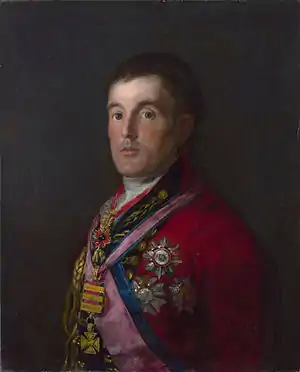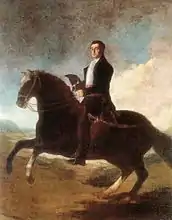Portrait of the Duke of Wellington
The Portrait of the Duke of Wellington is a painting by the Spanish artist Francisco Goya of the British general Arthur Wellesley, 1st Duke of Wellington during the latter's service in the Peninsular War.[1] One of three portraits Goya painted of Wellington, it was begun in August 1812, after the subject's entry into Madrid, showing him as an earl in red uniform and wearing the Peninsular Medal. The artist then modified it in 1814 to show him in full dress black uniform with gold braid and to add the Order of the Golden Fleece and Military Gold Cross with three clasps (both of which Wellington had been awarded in the interim).[2]
| Portrait of the Duke of Wellington | |
|---|---|
 | |
| Artist | Francisco Goya |
| Year | 1812–14 |
| Medium | Oil on mahogany panel |
| Dimensions | 64.3 cm × 52.4 cm (25.3 in × 20.6 in) |
| Location | National Gallery, London |
Description
The painting was probably made from life, at sittings in Madrid, painted in oils on a mahogany panel. Although a successful general, the Wellington depicted by Goya is tired from the long campaigning, having won a victory at the Battle of Salamanca on 22 July 1812 before triumphantly entering Madrid on 12 August 1812. The half-length portrait shows the subject in a three-quarter profile, facing to the right, with his head turned slightly to the left, towards the viewer. He is standing upright, with his head held high, perhaps to combat his relatively modest stature.
The face is carefully painted, but much of the painting was done quickly, with great energy, with the military orders outlined with a few brushstrokes. In some areas, such as the eyes and mouth, the brown priming remains visible to create a stronger contrast between light and dark areas of paint.
His uniform bears the insignia of several military orders. His left breast bears three stars: the British Order of the Bath (top, awarded in 1804), the Portuguese Order of the Tower and Sword (lower left, awarded in 1811) and the Spanish Order of San Fernando (lower right, awarded in 1812). He wears two broad sashes over his right shoulder: the pink sash of the Order of Bath over the blue sash of the Order of the Tower and Sword . Around his neck hangs the Order of the Golden Fleece (awarded in August 1812) on a red ribbon, the Military Gold Cross lying lower on longer pink and blue ribbons. Wellington was entitled to all nine gold clasps to the Military Gold Cross, but only three are shown, perhaps signifying the battles fought before the painting was started in the summer of 1812.
In 1812, Goya also completed a chalk drawing of Wellington, now held by the British Museum, and a large oil-on-canvas Equestrian portrait of the Duke of Wellington , which was exhibited at the Real Academia de Bellas Artes de San Fernando in Madrid in September 1812 and is now at Apsley House. X-ray analysis in the 1960 showed that the equestrian portrait has the head of Wellington added to a body painted previously, perhaps Manuel Godoy or Joseph Bonaparte.
Reception and theft
The painting was acquired by the Duke of Wellington, and came into the possession of Louisa Catherine Caton, wife of Francis D'Arcy-Osborne, 7th Duke of Leeds and sister-in-law of Wellington's older brother Richard Wellesley, 1st Marquess Wellesley. Her first husband Felton Hervey-Bathurst fought with Wellington in the Iberian Peninsula, commanding the 14th Light Dragoons from 1811 to 1814, and then on Wellington's staff in the Waterloo Campaign and Wellingtons representative at the signing of the Convention of St. Cloud on 3 July 1815.
It descended to John Osborne, 11th Duke of Leeds by the time it was put up for auction at Sotheby's in 1961. The New York collector Charles Wrightsman bid £140,000 (equivalent to £3,139,281 in 2019), but the Wolfson Foundation offered £100,000 and the government added a special Treasury grant of £40,000, matching Wrightsman's bid and obtaining the painting for the National Gallery in London, where it was first put on display on 2 August 1961. It was stolen nineteen days later, on 21 August 1961. It was later returned and Kempton Bunton confessed to taking the painting and its frame in July 1965.[3] Following a high-profile trial in which he was defended by Jeremy Hutchinson, QC, Bunton was found not guilty of stealing the painting, but guilty of stealing the frame.[4]
The theft entered popular culture, as it was referenced in the 1962 James Bond film Dr. No. In the film, the painting was on display in Dr. Julius No's lair, suggesting the first Bond villain had stolen the work.[3][5]
 Framed painting
Framed painting Goya's chalk drawing, 1812, British Museum
Goya's chalk drawing, 1812, British Museum Goya's Equestrian Portrait of the 1st Duke of Wellington, 1812, Apsley House
Goya's Equestrian Portrait of the 1st Duke of Wellington, 1812, Apsley House
References
- Notes
- National Gallery catalogue entry
- Kauffmann, Jenkins & Wieseman 2009, pp. 125–127
- Nairne 2011
- Serpell, Nick (14 November 2017). "The QC, Lady Chatterley and nude Romans". BBC News.
- Forbes Magazine 2006
- Sources
- "World's Greatest Art Heists". Forbes. 1 September 2006. Archived from the original on 23 February 2007.
- Kauffmann, C.M.; Jenkins, Susan; Wieseman, Marjorie E. (2009) [1982]. Catalogue of Paintings in the Wellington Museum, Apsley House (PDF) (Revised ed.). English Heritage in association with Paul Holberton Publishing. ISBN 978 1 903470 78 7.
- Nairne, Sandy (6 August 2011). "From the National Gallery to Dr No's lair". The Guardian.
- Equestrian Portrait of the 1st Duke of Wellington, Francisco de Goya, ArtUK
- Drawing of Arthur Wellesley, 1st Duke of Wellington, Francisco de Goya, British Museum
- Apsley House Collection, English Heritage
- "Goya's Wellington: The Duke Disappears", History Today, Volume 61 Issue 8, August 2011
- "Goya works among Spain's lost art gems to be shown at British Museum", The Guardian, 18 September 2012